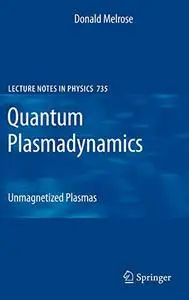Quantum Plasmadynamics: Unmagnetized Plasmas by Donald B. Melrose
English | PDF (True) | 2008 | 481 Pages | ISBN : 0387739025 | 3.8 MB
The idea of synthesizing quantum electrodynamics (QED) and the kinetic theory of plasmas ?rst occurred to me in the early 1970s [1, 2]. The project to do so has been carried out bit by bit over the subsequent years. The name “quantum plasmadynamics” (QPD) is my own jargon [3] for the synthesized theory. Both QED and the kinetic theory of plasmas areconcerned with the int- action between charged particles and the electromagnetic ?eld, but they are radically di?erent in the way the interaction is described. The kinetic theory of plasmas is a collective-medium theory: a plasma is not a collection of - dependent particles in a given electromagnetic ?eld, but a medium in which the particles collectively modify the ?eld, and the ?eld modi?es the par- cles. The charge and current densities associated with the particles are part of a self-consistent ?eld. Conventionally, the kinetic theory of plasmas is a classical theory: the motions of particles are treated using classical dynamics.



